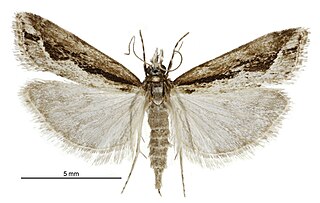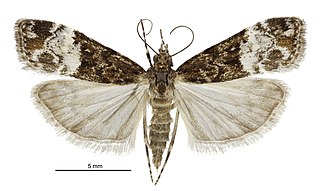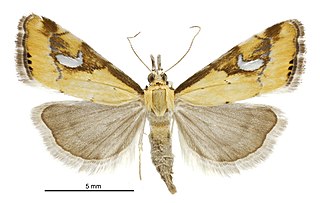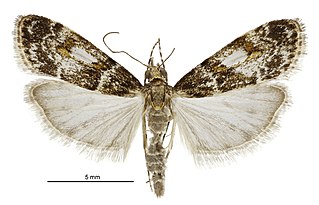
Eudonia is a large and widespread genus in the grass moth family (Crambidae), subfamily Scopariinae. There is no common name for the roughly 250 species placed here; new species are still being described regularly. Although the genus was proposed early in the 19th century, many of these moths were for a long time retained in Scoparia, the type genus of the subfamily and a close relative of Eudonia. A few small genera have been proposed for separation from Eudonia, but given the size of this group this is not particularly convincing; thus, all are retained here pending a comprehensive phylogenetic review.

Eudonia bisinualis is a species of moth in the family Crambidae. It was described by George Vernon Hudson in 1928. This species is endemic to New Zealand.

Eudonia submarginalis is a species of moth in the family Crambidae. It was described by Francis Walker in 1863. It is endemic to New Zealand.

Eudonia minualis is a species of moth of the family Crambidae. It was described by Francis Walker in 1866. It is endemic to New Zealand.

Eudonia steropaea is a species of moth of the family Crambidae. It was named by Edward Meyrick in 1884. Meyrick gave a detailed description of this species in 1885. It is endemic to New Zealand.

Eudonia minusculalis is a moth of the family Crambidae. It was described by Francis Walker in 1866. It is endemic to New Zealand. Adult moths have been recorded as visiting the flowers of Leptospermum scoparium and likely feeding from and pollinating them.

Glaucocharis bipunctella is a moth in the family Crambidae. It was described by Francis Walker in 1866. It is endemic to New Zealand.

Glaucocharis lepidella is a moth in the family Crambidae. It was described by Francis Walker in 1866. It is endemic to New Zealand. Larvae of this species feed on mosses.

Eudonia crypsinoa is a moth in the family Crambidae. It was named by Edward Meyrick in 1884. It is endemic to New Zealand.

Eudonia cymatias is a moth in the family Crambidae. It was named by Meyrick in 1884. This species is endemic to New Zealand.

Eudonia leptalea is a moth in the family Crambidae. This species is endemic to New Zealand, including the Chatham Islands.

Eudonia periphanes is a moth in the family Crambidae. It was named by Edward Meyrick in 1884. Meyrick gave a detailed description of this species in 1885. It is endemic to New Zealand.

Eudonia psammitis is a moth in the family Crambidae. It was named by Edward Meyrick in 1884. Meyrick gives a description of the species in 1885. It is endemic to New Zealand, including the Campbell Islands.

Eudonia cataxesta is a moth in the family Crambidae. It was described by Edward Meyrick in 1884. It is endemic to New Zealand.

Eudonia thyridias is a moth in the family Crambidae. It was described by Edward Meyrick in 1905. It is endemic to New Zealand.

Eudonia triclera is a moth in the family Crambidae. It was described by Edward Meyrick in 1905. It is endemic to New Zealand.

Eudonia torodes is a moth in the family Crambidae. It was described by Edward Meyrick in 1901. It is endemic to New Zealand.
Eudonia linealis is a species of moth in the family Crambidae. This species is endemic to New Zealand. It is classified as "Data Deficient" by the Department of Conservation.

Eudonia sabulosella is a species of moth in the family Crambidae. This species is endemic to New Zealand and is regarded as being common. The larvae of this species are known to damage pasture in New Zealand.


















